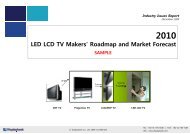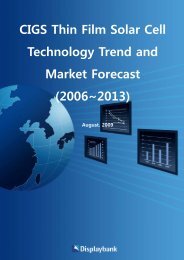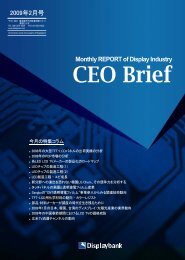Solar Grade-Silicon, Ingot, Wafer Technology and ... - Displaybank
Solar Grade-Silicon, Ingot, Wafer Technology and ... - Displaybank
Solar Grade-Silicon, Ingot, Wafer Technology and ... - Displaybank
You also want an ePaper? Increase the reach of your titles
YUMPU automatically turns print PDFs into web optimized ePapers that Google loves.
<strong>Solar</strong> <strong>Grade</strong>-<strong>Silicon</strong>, <strong>Ingot</strong>, <strong>Wafer</strong> <strong>Technology</strong> <strong>and</strong> Market Trend (2008~2012)<br />
8.2. Figure<br />
Figure 1.1.1 Long-Term Forecast of Power Generation Volume by Global Energy Source .......................................<br />
Figure 1.1.2 Potential Energy Volume of the Earth ....................................................................................................<br />
Figure 1.1.3 Types of <strong>Solar</strong> Cell .................................................................................................................................<br />
Figure 1.1.4. Rouch Comparison of Generation Unit Cost by Power Source .............................................................<br />
Figure 1.1.5. Module Manufacturing Unit Cost upon Cell Efficiency ........................................................................<br />
Figure 1.1.6. Composition Ratio of <strong>Solar</strong> Cell Manufacturing Unit Cost ...................................................................<br />
Figure 1.1.7 <strong>Wafer</strong> <strong>and</strong> Module Manufacturing Unit Cost upon p-Si Manufacturing 1 Unit Cost .............................<br />
Figure 1.2.1. <strong>Silicon</strong> <strong>Solar</strong> Cell Value Chain ..............................................................................................................<br />
Figure 1.2.2. <strong>Technology</strong> Direction for Inexpensive <strong>Solar</strong> Cell Material ...................................................................<br />
Figure 1.3.1. <strong>Silicon</strong> <strong>Solar</strong> Cell Manufacturing Process .............................................................................................<br />
Figure 1.3.2. Monocrystalline <strong>Ingot</strong> Manufacturing Process ......................................................................................<br />
Figure 1.3.3. Polycrystalline <strong>Silicon</strong> <strong>Wafer</strong> Manufacturing Process ...........................................................................<br />
Figure 2.1. Market Share <strong>and</strong> Forecast of p-Si Manufacturing <strong>Technology</strong> ...............................................................<br />
Figure 2.2. Metal Impurity Concentration Limit of <strong>Solar</strong> Cell p-Si ...........................................................................<br />
Figure 2.3. Nonmetal Impurity Concentration Limit of <strong>Solar</strong> Cell p-Si .....................................................................<br />
Figure 2.1.1. MG <strong>Silicon</strong> Manufacturing Process (Elkem).........................................................................................<br />
Figure 2.1.2. SiO Equilibrium Vapor Pressure upon Temperature ..............................................................................<br />
Figure 2.1.3 Achro Used in <strong>Silicon</strong> Reduction (ECN)................................................................................................<br />
Figure 2.1.4. Carbothermic Reduction (ECN) ............................................................................................................<br />
Figure 2.2.1. Environmental Variatios Need to be Considered in Each Process .........................................................<br />
Figure 2.9. Basic Structure of Bell-jar Reactor Used in Siemens Method ..................................................................<br />
Figure 2.10. Interior of Siemens Reactor ..................................................................................................................<br />
Figure 2.11. U-Bar Arragement Inside of Siemens Reactor ......................................................................................<br />
Figure 2.12. <strong>Silicon</strong> U-Bar Manufactured by Siemens Method ................................................................................<br />
SAMPLE<br />
Figure 2.13. <strong>Silicon</strong> Chunk Obrained by Pulverizing <strong>Silicon</strong> U-Bar ........................................................................<br />
Figure 2.3.2.1 Deposition Principle of TCS-based <strong>and</strong> MS-based ...........................................................................<br />
Figure 2.4.1 Fluidized Bed Reactor ..........................................................................................................................<br />
Figure 2.4.2 VLD Method Concept ..........................................................................................................................<br />
Figure 2.4.3 <strong>Silicon</strong> Production Plant in Tokuyaman Using VLD Method ..............................................................<br />
Figure 2.4.4 Property of <strong>Ingot</strong> Refined Using VLD Method ....................................................................................<br />
Figure 2.19. Tube Reactor in Joint <strong>Solar</strong> <strong>Silicon</strong> (JSSi) Process ..............................................................................<br />
Figure 2.20. <strong>Silicon</strong> Underwent High-Density Process ............................................................................................<br />
Figure 2.5.1 Impurities in MG-Si: Equilibrium Distribution Coefficient .................................................................<br />
Figure 2.5.2 Metal Impurities Employment within <strong>Silicon</strong> ......................................................................................<br />
Figure 2.5.3 Acid Leaching Process Outline .............................................................................................................<br />
Figure 2.5.4. SOLSILC Project Structure Map .........................................................................................................<br />
All Contents of this report remain the property of <strong>Displaybank</strong><br />
Jan’09











